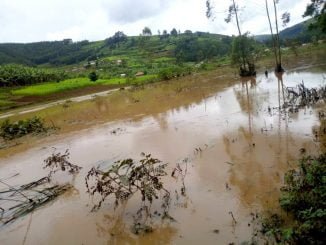
Kampala, Uganda | URN | The current floods being experienced in Southern parts of the country will subside in January next year while in other parts at the end of December.
The floods which worsened in September has left several parts of the country cut off with landslides accompanying heavy rains in some hilly areas of Bundibugyo and Bududa districts.
Uganda National Meteorological Authority (UNMA) says the above normal rains were caused by temperature and pressure difference over the Eastern and Western Indian Ocean – a phenomenon scientifically known as the Indian Ocean Dipole.
Particularly, the one which triggered this year’s flood is known as the Positive Indian Ocean Dipole, Deus Bamanya, the Director of Applied Meteorology, Data and Climate Services at Uganda National Meteorological Authority says.
Bamanya says the Indian Ocean Dipole refers to the difference in sea-surface temperatures in opposite parts of Indian Ocean adding that it oscillates between Positive, Negative and Neutral states.
When Positive Indian Ocean Dipole occurs, the western Indian Ocean or the East African Coast becomes warmer and eastern part of Indian Ocean (Asia) becomes colder, and then becomes negative phase when the reverse is true.
When a positive Indian Ocean Dipole occurs, it aids higher evaporation and creates a low pressure zone in the western part of the ocean (East African Coast). And because hot air rises up, the cold winds in the colder Eastern part flow to occupy the vacuum left behind in the Western part.
This time, the reverse winds coming over the Western part of Indian Ocean arrived with lots of moisture triggering heavy rains in the African Continent near the Equator (the East African coast).
The arrival of the moist winds strengthened the Inter Tropical Convergence Zone (ITCZ) – a system of wind circulation responsible for rainfall formation over different seasons.
Read Also: Ugandan MPs seek penalties for motorists who splash water on pedestrians
The strengthened ICTZ is what led to larger and more widespread storm clouds that resulted into wetter conditions across many East African Countries.
According to World Meteorological Organization, this year’s Indian Ocean Dipole has been the strongest on record since 2001 with surface temperature peaking up to +2.1 Degrees Celsius in mid-October.
Although it is currently weakening, recent observations put it at +0.9°C, which is still well above the positive IOD threshold value of +0.4 °C, indicating that the current rains are reducing but can be sustained in the southern sector of Uganda till the end of December 2019.
The current rains have not affected Uganda alone, but also other neighbouring countries which include Kenya, Tanzania, South Sudan, Sudan, Ethiopia, Somalia, DR Congo, and Central African Republic.
On the other side of Indian Ocean, it triggered droughts accompanied by bush fires. The strange weather phenomenon arrived shortly after Tropical Cyclone Idai hit the Coast of Mozambique and disorganized the return of early rainfall over the East African region.
Scientists say such adverse weather conditions will be exacerbated by Climate Change which will increase their frequencies of occurrences.



